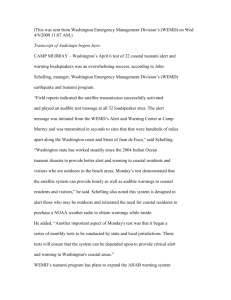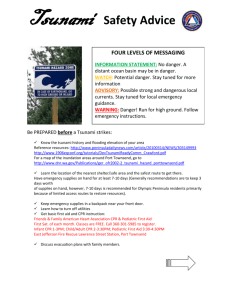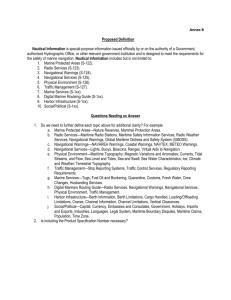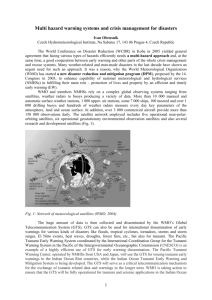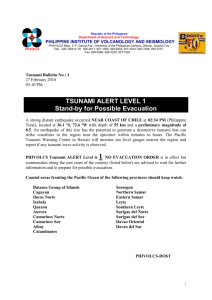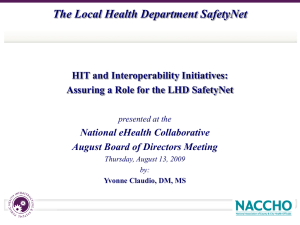GMDSS-Contribution
advertisement
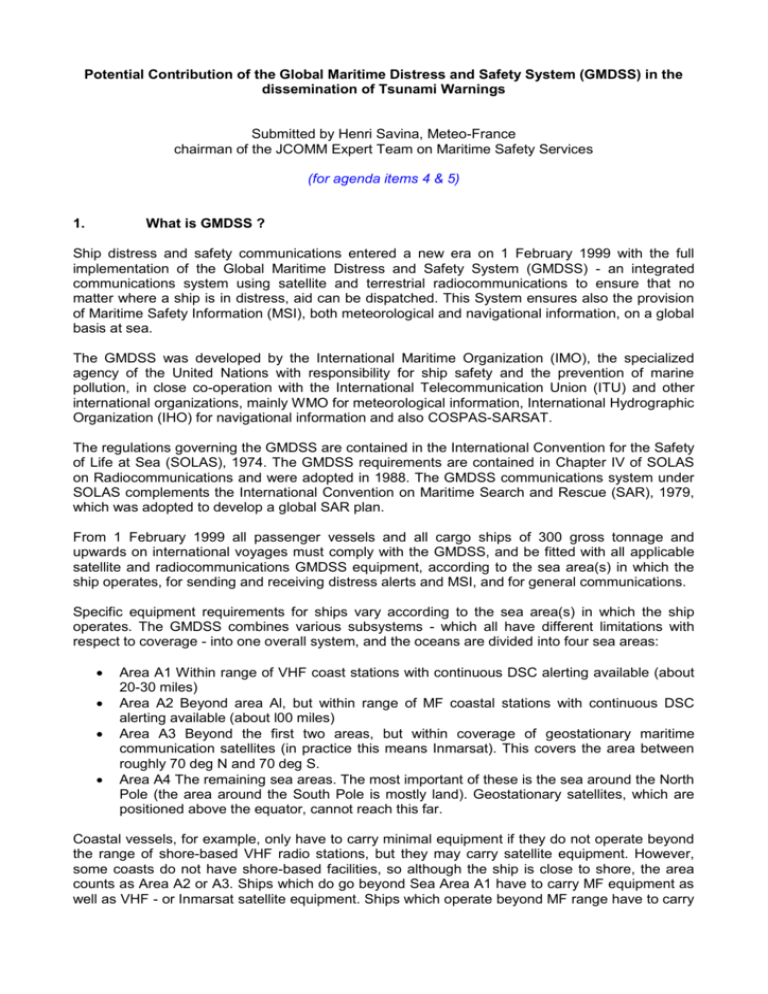
Potential Contribution of the Global Maritime Distress and Safety System (GMDSS) in the dissemination of Tsunami Warnings Submitted by Henri Savina, Meteo-France chairman of the JCOMM Expert Team on Maritime Safety Services (for agenda items 4 & 5) 1. What is GMDSS ? Ship distress and safety communications entered a new era on 1 February 1999 with the full implementation of the Global Maritime Distress and Safety System (GMDSS) - an integrated communications system using satellite and terrestrial radiocommunications to ensure that no matter where a ship is in distress, aid can be dispatched. This System ensures also the provision of Maritime Safety Information (MSI), both meteorological and navigational information, on a global basis at sea. The GMDSS was developed by the International Maritime Organization (IMO), the specialized agency of the United Nations with responsibility for ship safety and the prevention of marine pollution, in close co-operation with the International Telecommunication Union (ITU) and other international organizations, mainly WMO for meteorological information, International Hydrographic Organization (IHO) for navigational information and also COSPAS-SARSAT. The regulations governing the GMDSS are contained in the International Convention for the Safety of Life at Sea (SOLAS), 1974. The GMDSS requirements are contained in Chapter IV of SOLAS on Radiocommunications and were adopted in 1988. The GMDSS communications system under SOLAS complements the International Convention on Maritime Search and Rescue (SAR), 1979, which was adopted to develop a global SAR plan. From 1 February 1999 all passenger vessels and all cargo ships of 300 gross tonnage and upwards on international voyages must comply with the GMDSS, and be fitted with all applicable satellite and radiocommunications GMDSS equipment, according to the sea area(s) in which the ship operates, for sending and receiving distress alerts and MSI, and for general communications. Specific equipment requirements for ships vary according to the sea area(s) in which the ship operates. The GMDSS combines various subsystems - which all have different limitations with respect to coverage - into one overall system, and the oceans are divided into four sea areas: Area A1 Within range of VHF coast stations with continuous DSC alerting available (about 20-30 miles) Area A2 Beyond area Al, but within range of MF coastal stations with continuous DSC alerting available (about l00 miles) Area A3 Beyond the first two areas, but within coverage of geostationary maritime communication satellites (in practice this means Inmarsat). This covers the area between roughly 70 deg N and 70 deg S. Area A4 The remaining sea areas. The most important of these is the sea around the North Pole (the area around the South Pole is mostly land). Geostationary satellites, which are positioned above the equator, cannot reach this far. Coastal vessels, for example, only have to carry minimal equipment if they do not operate beyond the range of shore-based VHF radio stations, but they may carry satellite equipment. However, some coasts do not have shore-based facilities, so although the ship is close to shore, the area counts as Area A2 or A3. Ships which do go beyond Sea Area A1 have to carry MF equipment as well as VHF - or Inmarsat satellite equipment. Ships which operate beyond MF range have to carry Inmarsat satellite equipment in addition to VHF and MF. Ships which operate in area A4 have to carry HF, MF and VHF equipment. Under the GMDSS requirements, all ships are required to be equipped with Inmarsat and/or NAVTEX receivers, to automatically receive MSI. At the moment, most fishing vessels and recreational boaters are not required to participate in the GMDSS. For broadcast purposes, the world's oceans are divided into 16 areas, called either Metareas (for meteorological information) or Navareas (for navigational warnings) – see Annex 1. Regarding meteorological information, each Metarea is under the responsibility of a National Meteorological Service (NMS), named Issuing Service. Other NMS may provide some information, as Preparation Services. The issuing Service is responsible for the provision of meteorological information on the Inmarsat SafetyNET broadcast and also for the coordination of such information on the NAVTEX broadcast within its Metarea. The International Mobile Satellite Organization (IMSO), previously the International Maritime Satellite Organization, was established by IMO in 1976 to operate satellite maritime communication systems (and in particular the Inmarsat satellites) and has become a privately owned company, while retaining its public sector obligations to the maritime distress and safety system. Inmarsat provides the space segment capacity to the GMDSS, including interaction with all Inmarsat LES (Land Earth Stations) operated by independent Telecom Corporations around the world. This space segment constellation provides a world-wide satellite coverage, except for the extreme polar regions. 2. GMDSS coordination mechanisms The WMO contribution to the GMDSS, i.e. the dissemination of warnings and weather and sea bulletins according to a broadcast schedule, is coordinated by the WMO/IOC Joint Technical Commission for Oceanography and Marine Meteorology (JCOMM). JCOMM is an intergovernmental body of experts, which provides the international, intergovernmental coordination, regulation and management mechanism for an operational oceanographic and marine meteorological observing, data management, capacity building and services system. Until the formation of JCOMM in 1999, the coordination of these activities was provided by two separate bodies: the WMO Commission for Marine Meteorology (CMM) and the Joint IOC/WMO Committee for the Integrated Global Ocean Services System (IGOSS). JCOMM is the result of the recognition of the increasing demand for integrated marine meteorological and oceanographic data and services, and the efficiencies that may be achieved by combining the expertise and technological capabilities of the WMO and IOC systems. JCOMM is organized within four Programme Areas, each managed by a Coordinator and small Coordination Group - Observations, Data Management, Services, and Capacity Building. Within each Programme Area, specific activities are undertaken by a number of Expert Teams, Task Teams and Panels. Overall guidance and oversight for the work of the Commission is provided by a Management Committee, chaired by the two co-presidents of JCOMM, and including the four Programme Area Coordinators, representatives of GOOS, GCOS and IODE, and a small number of other selected experts. The nine members of the current Committee include four meteorologists, four oceanographers and one polar region expert. JCOMM structure is available in Annex 2. The coordination of the delivery of the safety-related marine meteorological and associated oceanographic services as an integral part of GMDSS is under the responsibility of the Expert Team on Maritime Safety Services (ETMSS) from the Services Programme Area. In particular, this Team has a mandate to prepare and submit both regulatory (what Member States shall do) and guidance (what Member States should do) material, that are included either in the Manual on Marine Meteorological Services (MMMS - WMO n°558) or in the Guide on Marine Meteorological Services (GMMS - WMO n°471). The Terms of Reference of that Team are available in Annex 3. All meteorological information prepared for SafetyNET broadcast are also available on the JCOMM GMDSS website (http://weather.gmdss.org), developed and maintained by Meteo-France. More generally, the procedures and regulations regarding the provision of MSI within the GMDSS framework are coordinated by the IMO SafetyNET and NAVTEX Co-ordinating Panels. Those Panels are responsible to update both IMO International SafetyNET and NAVTEX Manuals (that detail in particular specific format headers that shall be used). To participate as an information provider in the International SafetyNET Service, all Issuing Services must register with the IMO SafetyNET Panel (chaired by Peter M. Doherty, US NAVAREA Co-ordinator, National Geospatial-Intelligence Agency) to obtain a Certificate of Authorisation. This Certificate is requested to get permission from Inmarsat Land Earth Station Operators (LESOs) to broadcast on SafetyNET channel. The IMO NAVTEX Panel (chaired by Steve Godsiff from UK Hydrographic Office) is also responsible to provide and coordinate the identification letter and the time slots allocated to each NAVTEX station (keeping in mind that a single frequency – 518 KHz – is used world-wide for International NAVTEX service). 3. How can GMDSS contribute to dissemination of Tsunami Warnings At this stage, Tsunami Warnings are very briefly mentioned in both Manual and Guide on Marine Meteorological Services (MMMS and GMMS), in section “services for main ports & harbour areas” in the Manual (containing only general characteristic on this phenomenon, without specification for format and content) and in section “services for coastal and offshore areas” in the Guide (still no specification, but few examples of messages prepared by JMA for NAVTEX broadcast are included - see annex 4). The recent tragedy resulting from the Sumatran earthquake of 26 December 2004, and the consequent devastating tsunami waves, have demonstrated, among other things, the overwhelming importance of having in place global, operational, robust and accurate tsunami warning services. Regarding Tsunami Warnings dissemination, all potential channels to alert threatened people and activities should be considered, including existing (or planned) National and International systems implemented for the provision of MSI to the maritime community. The obvious reason is that all vessels in exposed areas (i.e. in ports, harbours or coastal areas) can be damaged or destroyed by tsunamis. Crews can also be injured or lost. They should then benefit from an early and timely tsunami warning to take appropriate safety actions (evacuation to deeper water for example). Additionally, some of these broadcasting systems, for example the SafetyNET International service could be used either directly to disseminate warnings to the relevant government offices (having either maritime and/or public safety responsibilities) or indirectly to some en-users (or even government offices especially in an interim phase) using SOLAS vessels, if any, as relays especially in coastal areas with nonexistent, inadequate or limited telecommunications infrastructure, both in the interim phase and in the expected operational system. It could be seen, at least, as a supplementary way to reach maritime and coastal communities. Although appropriate exchanges and coordination between Tsunami Centres and government offices shall also be implemented at a National level for the dissemination of early tsunami warnings through National MSI broadcast systems, where existing (VHF, HF,…..), this paper is focused on the dissemination of such warnings through the GMDSS, that is a system coordinated internationally. Approximately 10 years ago, NOAA sought permission for broadcast tsunami warnings via SafetyNET. Permission was refused at that time, the rationale being that SafetyNET is intended for vessels on the high seas which would not be affected by a tsunami. The last IMO sub-committee on radio-communications and search and rescue (IMO COMSAR/9) hold in February 2005, much discussed this point and more generally the potential contribution of GMDSS within a Tsunami (or more generally Natural Disaster) Early Warnings System. The main proposals that seem to arise were : use SafetyNET to broadcast warnings of tsunamis of significance for ocean navigation (if any) and coastal areas not covered by NAVTEX to ships at sea, via the International SafetyNET Service. Authorise Tsunami Warning Centres to be information providers on SafetyNET and establish a set of operational criteria for them to use, plus specimen texts to keep the amount of information to the minimum consistent with safety. use NAVTEX to broadcast tsunami warnings to coastal areas, routing information via the National NAVTEX co-ordinator where possible. Similar guidance would be needed in the NAVTEX Manual. consider SafetyNET as one possible means of broadcasting information from the tsunami warning centres to local government offices in regions expected to be affected by tsunami events. This info would not normally be printed out in ships (although some ships would receive it). Inmarsat has made some proposals to IMO as to the means of doing this. There are alternative methods, but SafetyNET offers some advantages: simultaneous receipt in all of the offices linked to the network, low-cost broadcasts (free for any messages given distress priority), etc. There are also disadvantages to using a store-and-forward system, so this might not prove to be the best solution available. In the interim (before the update of the guidance documents), COMSAR/9 agreed to recommend the approval of a COMSAR circular which provides advice on the promulgation of tsunami and other urgent natural disaster warnings using the existing SafetyNET and/or NAVTEX systems (see draft text included in Annex 5 for information only). It was also agreed that a Correspondence Group should consider the issue of the promulgation of tsunami and other natural disaster warnings for vessels which are not subject to the provisions of the 1974 SOLAS Convention (i.e. passenger and cargo ships engaged on domestic voyages, cargo ships engaged on international voyages whose gross tonnage is less than 500, fishing vessels, ships of primitive build and pleasure yachts not engaged in trade). 4. Actions to be performed There are still actions to performed or points to clarify : Classification of Tsunami Warnings (or other natural disaster warnings) within the MSI Those warnings could be seen either as part of the World-Wide Navigational Warning Service (WWNWS), coordinated by IHO (and NAVAREA co-ordinators) or as part of Meteorological information, coordinated by WMO/JCOMM (and METAREA co-ordinators). COMSAR/9 agreed that a complete review of the World-Wide Navigational Warning Service WWNWS guidance documents was required (The WWNWS guidance documents include the IMO International SafetyNET Manual, the IMO NAVTEX Manual, the Joint IMO/IHO/WMO Manual on Maritime Safety Information, the IHO/IMO World-Wide Navigational Warning Service Guidance Document . Special Publication No. 53, and the Joint IMO/IHO/WMO Manual on Maritime Safety Information. Special Publication S-53 . Appendix 1.) and asked the IHO Commission for the Promulgation of Radio Navigational Warnings (CPRNW). But, since it is clear that many NMSs in maritime countries had national responsibilities for some aspects of the tsunami warning process and that a future tsunami warning system must be developed as part of a more comprehensive natural marine hazards warning system, encompassing, for example, storm surges, tropical cyclones, extreme waves, etc..., this strongly implies a future role for JCOMM in this process. Then, MMMS (WMO n°581) and GMMS (WMO n°471) should be updated accordingly. Even if it is transparent for end-users, this point should be clarified between IMO, IHO and WMO, for regulation and guidance materials and documentations. Some discussions may take place in the margins of the Extraordinary IH conference in Monaco (11-16 April 2005) and during CPRNW, SafetNET & NAVTEX Panels meetings planned in IHO Headquarters in Monaco (12-15 September 2005). Specific arrangements for the interim phase may also be adopted. A draft paper, prepared for the update of the International SafetyNET Manual, is included as Annex 6 for information only. This paper has not been formerly approved yet and should not be used in operations. Information to be provided on GMDSS As the bandwidth for additional SafetyNET and especially NAVTEX broadcasts is limited, it will be important to avoid overloading the general MSI broadcasts with irrelevant or redundant tsunami data. As requested by IMO, a set of operational criteria and specimen texts should be established for Issuing Services, to keep the amount of information to the minimum consistent with safety. If we suppose that the categories of messages are the same as in the Pacific (Information, Watches, Warnings, Confirmations of warning), only warnings and confirmations (watches to be studied) should be provided through the GMDSS, keeping in mind that the aim is to miss no significant tsunami and keep the rate of false alarms as a minimum. Concise and comprehensive vocabulary should be used to keep the volume of messages to the minimum size. Format shall be clearly described, in particular to separate each kind of messages : the warnings (risk) and the confirmations. Content shall include at least : Type of message Threatened coastal areas Period concerned (especially for coastal areas far from the seismic point - if not : “IMMINENT” or “IN FORCE”) Issuing Service Date/Time Additional information (location and intensity of the seism) could exceptionally be added. Cooperation and harmonisation should be sought from the countries involved in the existing Tsunami Warning System for the Pacific ocean. Regarding the provision within the International SafetyNET service, redundancy shall be avoided and international coordination is requested. A possible permanent solution could be to use the SafetyNET, to get warnings from the Regional Warning Centre(s) direct to the appropriate national authorities (and to SOLAS ships in Metareas concerned if needed). The national authorities may then decide, as part of their national contingency plan, to broadcast the warning to shipping in coastal areas using either NAVTEX or SafetyNET in lieu of NAVTEX (if not redundant with “regional” broadcast) where these facilities have been established. Considering the velocity of tsunamis, the general recommendation regarding dissemination is to reduce transitions : the faster, the better. Operate automatic systems and keep the human interventions as a minimum should be preferred. The procedure for dissemination of Tsunami warnings on International SafetyNET service (see draft text, for information only, in Annex 6) is also to be formally approved by IMO. Guidelines for SOLAS vessels The dissemination of such warnings on the GMDSS to SOLAS vessels could be useless if clear guidelines or recommendations (some kind of checklists, that may depend on the type and content of the received message) are not provided to mariners, both for their own safety and for their potential actions as relay. Even if COMSAR/9 agreed that it was not in a position to expand on the development of guidelines for disaster emergency preparedness and response for ships at sea and in coastal areas, this need is clearly within the IMO scope. Recommendations or guidelines regarding the action(s) as a relay is quite a difficult issue. While there is clearly some potential for SOLAS ships to consider immediate re-broadcasting of any tsunami warnings in coastal areas using all available means as appropriate, presumably via VHF (or HF), there is no precedent for this and most seafarers would probably don’t know what to do if asked. There is also the issue of who would receive such broadcasts on Channel 16. Few local fishing boats are fitted with VHF, although most tourist boats are. The problem is also to see how that recommendation would reach the people who would need to know about it. At least during the interim phase, or even later for some areas, SOLAS ships could be asked also to relay this information either to the Maritime Rescue Coordination Centres (MRCC) or to the local or nearest port authorities, for them to disseminate to both maritime and coastal communities (such centres or offices should then have clear procedures). National contingency plans should also include the dissemination of the alert to the relevant national offices in charge of the provision of national MSI and of maritime rescue (MRCC). 5. Elements for Draft Work Plan (dissemination interim phase, operational system) The contribution of the GMDSS in the dissemination of tsunami warnings could be implemented first for the Pacific Ocean, as Regional and National Tsunami Warning Centres exist and could issue the according messages, if necessary through the Metarea(s) or Navarea(s) co-ordinator(s) for the International SafetyNET service. Some provision may already exist, probably for the International NAVTEX service in Japan or USA, but significant consolidations, adaptations or modifications in the existing products and systems may be required. However, the process could start quickly. Regarding the Indian Ocean, the key point is to identify the centre(s) that will act as Regional or National levels. As said before, a possible permanent solution could be to use the SafetyNET, to get warnings from the Regional Warning Centre(s) direct to the appropriate national authorities and to SOLAS ships in Metareas concerned. The national authorities may then decide, as part of their national contingency plan, to broadcast the warning to shipping in coastal areas using either NAVTEX or SafetyNET in lieu of NAVTEX (if not redundant with “regional” broadcast) where these facilities have been established. In the interim phase, if the Pacific Tsunami Warning Centre (PTWC) provides also Indian-wide warnings, those messages could be issued on SafetyNET directly or via ad-hoc Metarea(s) coordinators. Appropriate procedures and mechanisms have to be decided and implemented. Annex 1 - Metareas Annex 2 – JCOMM structure Annex 3 NEW DRAFT TERMS OF REFERENCE AND GENERAL MEMBERSHIP OF THE COORDINATION GROUP AND EXPERT TEAMS OF THE SERVICES PROGRAMME AREA (for submission to JCOMM-II in September 2005) 1. Expert Team on Maritime Safety Services Terms of Reference The Expert Team on Maritime Safety Services, in close collaboration with IMO, IHO, ICS, IMSO and other concerned organizations and bodies on maritime safety issues, including the GMDSS, shall: (a) (b) Monitor and review the operations of marine broadcast systems, including for the GMDSS and others for vessels not covered by the SOLAS convention; Monitor and review technical and service quality standards for meteorological and oceanographic maritime safety information, particularly for the GMDSS, and provide assistance and support to Members and Member States as required; (c) Ensure feedback from the user communities is obtained through appropriate and organised channels and applied to improve the relevance, effectiveness and quality of services; (d) Ensure effective coordination and cooperation with concerned organizations, bodies and Members and Member States on maritime safety issues; (e) Propose actions as appropriate to meet requirements for international coordination of meteorological and related communication services; (f) Provide advice to the Services CG and other Groups of JCOMM, as required on issues related to maritime safety services. General Membership Chair, selected by the Commission. OPEN membership, including representatives/nominations of the Issuing Services for the GMDSS, representatives of IMO, IHO, ICS, IMSO, and other user groups as appropriate. The Chair, in consultation with the co-presidents of the Commission, should secure support to enable appropriate and adequate participation in the meetings of this group. Annex 4 Samples of tsunami warning issued by JMA for NAVTEX Broadcast (issued from the Guide to Marine Meteorological Services – WMO n°471) WEJP65 RJTD 171225 FOR KUSHIRO NAVTEX AREA EMERGENCY TSUNAMI WARNING TSUNAMI EXPECTED PACIFIC COAST OF HOKKAIDO PACIFIC COAST OF NE HONSHU ISSUED FROM JMA TOKYO AT 171225 UTC= WEJP85 RJTD 171225 FOR KUSHIRO NAVTEX AREA FOLLOWING WARNING IS VALID NOW TSUNAMI EXPECTED PACIFIC COAST OF HOKKAIDO PACIFIC COAST OF NE HONSHU ISSUED FROM JMA TOKYO AT 171225 UTC= WEJP64 RJTD 171225 FOR OTARU NAVTEX AREA EMERGENCY TSUNAMI WARNING TSUNAMI EXPECTED PACIFIC COAST OF HOKKAIDO PACIFIC COAST OF NE HONSHU ISSUED FROM JMA TOKYO AT 171225 UTC= WEJP84 RJTD 171225 FOR OTARU NAVTEX AREA FOLLOWING WARNING IS VALID NOW TSUNAMI EXPECTED PACIFIC COAST OF HOKKAIDO PACIFIC COAST OF NE HONSHU ISSUED FROM JMA TOKYO AT 171225 UTC= Annex 5 [DRAFT PAPER] BROADCAST OF WARNINGS FOR TSUNAMIS AND OTHER NATURAL DISASTERS 1 The Sub-Committee on Radiocommunications and Search and Rescue (COMSAR), at its ninth session (7 to 11 February 2005) considered the promulgation of warnings for tsunamis and other natural disasters using the existing SafetyNET and/or NAVTEX systems and agreed to the following, pending the review of resolution A.706(17) on World-Wide Navigational Warning Service. 2 Tsunami Warning Centres and those who may seek to broadcast warnings as a result of natural disasters (natural disaster warnings) may make use of the existing SafetyNET system. As a first step each Tsunami Warning Centre and those who may seek to broadcast natural disaster warnings must register with the IMO SafetyNET Panel* to obtain a certificate of authorization. A detailed procedure of the steps to be taken following registration is set out in annex 1. 2.1 NAVAREA and National Co-ordinators in the affected areas, or areas likely to be affected, upon receipt of any tsunami warning or of any other natural disaster warnings should immediately re-broadcast such warnings using the highest priority and all existing means as appropriate. 3 In the interim and until Tsunami Warning Centres are established and registered, those who may seek to broadcast tsunami or natural disaster warnings they may use the World-Wide Navigational Warning Service (WWNWS) to broadcast such warnings both regionally and locally. This may be achieved by contacting the NAVAREA or National Co-ordinators for the affected areas, or areas likely to be affected. The Geographic areas for co-ordinating and promulgating NAVAREA and the contact details of the NAVAREA Co-ordinators under the WWNWS are set out in annexes 2 and 3. 3.1 NAVAREA and National Co-ordinators in the affected areas or areas likely to be affected should consider tsunami warnings and warnings for other natural disasters as exceptional circumstances and should immediately broadcast such warnings using the highest priority and all existing means as appropriate. 4 Ships, when within affected areas, should consider immediate re-broadcasting of any tsunami warnings and/or any other natural disaster warnings they might receive using all available means (e.g. VHF radio) as appropriate. In addition, ships should consider activating any emergency response procedures and arrangements they deem necessary and to prepare, depending on the circumstances, for the conduct of search and rescue operations. Ships should also consider, in the light of the prevailing circumstances, the need for changes to planned navigational routes. Annex 6 [DRAFT PAPER] STEPS TO BE TAKEN FOR THE PROMULGATION OF TSUNAMI WARNING AND OTHER DISASTER WARNINGS, USING INMARSAT C SAFETYNET SERVICES. The steps given in this Annex are in accordance with the IMO International SafetyNET Manual, 2003 edition. It should be noted that this Annex provides only general guidelines on access to the SafetyNET service and detailed procedure may vary among different Inmarsat C Land Earth Station Operators (LESOs). 1. Registration with IMO SafetyNET Co-ordinating Panel A Tsunami Warning Centre and those who may seek to broadcast disaster warnings must register with the IMO SafetyNET Panel to obtain a Certificate of Authorisation to participate as an information provider in the International SafetyNET Service. The International SafetyNET Co-ordinating Panel can be contacted at the following address: Mr Peter M Doherty Chairman, International SafetyNET Co-ordinating Panel National Geospatial-Intelligence Agency 4600 Sangamore Road Bethesda, MD 20816-5003 United States of America Tel: +1 301 227 7646 Fax: +1 301 227 3731 E-mail: DohertyP@nga.mil 2. Registration with Inmarsat C LESO LESOs offer SafetyNET service only to authorised information providers. In order to send EGC SafetyNET messages, a registered information provider must then send the Certificate of Authorisation to a LESO and ask for registration. An information provider may select any LESO covering the area concerned and offering the required service. A list of all LESOs is attached to this Annex. After registration, the LESO will send you a username, password and general information on how to access the required service. Access to the service is given via two-stage telex, via PSTN or PSDN or via the Internet. 3. Operational procedures 3.1. Message address Depending on the individual LESO, a message address varies and each information provider will be given detailed information how to submit a message to the LES. In general, the address of a message sent via the Internet is in the form of an e-mail address as, for example, EGC@xxx.xxx.net or EGC@xxx.xxx.com, etc 3.2. Broadcast parameters To broadcast a message an information provider should also submit C-codes with the message, usually five or six codes, which are known as broadcast parameters and are included in the message header. As common practice for messages sent via Internet, C-codes are included in the “Subject” field/line of the e-mail user interface. Each C-code controls an individual broadcast parameter and is assigned a numerical value in accordance with the IMO SafetyNET Manual. The EGC SafetyNET broadcast command syntax is as follows: EGC C0,C1,C2,C3,C4,C5 (spaces, commas, colons or other delimiters between codes are required and may vary depending on the LES) Where the word EGC is the start command, it is followed by a “space” C0 – Ocean Region, an optional code to identify the Inmarsat ocean region if the addressed LES operates in more than one ocean region C0=0 – Atlantic Ocean Region West (AOR-W) C0=1 – Atlantic Ocean Region East (AOR-E) C0=2 – Pacific Ocean Region (POR) C0=3 – Indian Ocean Region (IOR) C0=9 – All Ocean Regions covered by the LES (optional) C1 – Priority code C1=1 – Safety priority C1=2 – Urgency priority C1=3 – Distress priority It is strongly recommended to use “Urgency” or “Distress” priority since it gives priority over other non-urgent messages in the Inmarsat C system and also causes audible and visual alarms on the mobile terminal. C2 – Service code At the moment, there is no specific service code defined for tsunami or other disaster warnings, the following codes (after agreement with the SafetyNET Co-ordinating Panel) could be used: C2 = 04 – Currently, navigational warnings to rectangular area C2 =13 – Currently, coastal warning – option to address a message to restricted number of ships/shore based authorities who have programmed their mobile terminals with the required codes. C3 – Address code Rectangular address consists of 12 digits as follows: D1D2LaD3D4D5LoD6D7D8D9D10 Where: D1D2 - latitude of south-west corner of the rectangle in degrees La – hemisphere N (North) or S (South) D3D4D5 – longitude of south-west corner of the rectangle in degrees with leading zero if required Lo – longitude E (east) or W (West) D6D7 – extent of rectangle in latitude to the North in degrees D8D9D10 – extent of rectangle in longitude to the East in degrees A rectangle, whose S-W corner is 20oS and 61oE, extending 28o to the North and 74o to the East, is coded as 20S061E28074 Note: The value of latitude is limited from 00o to 90o and longitude from 000o to 180o Coastal warning address consists of 4 characters - 2 digits and 2 letters as follows: X1X2B1B2 Where: X1X2 – NAV/METAREA in range of 01 – 16 and B1B2 – NAVTEX codes to allocate NAVTEX transmitter coverage area (B1) and type of warning (B2) An example of coastal warning address may be as 08ZL where: 08 – message addressed to ships in NAV/METAREA VIII Z – NAVTEX coverage area L – type of warning (e.g. Tsunami) C4 – Repetition code A repetition code allows a message to be repeated a finite number of times or at specific intervals until cancelled by the information provider. C4=01 – transmit once on receipt C4=11 – transmit on receipt followed by repeat 6 minutes later ……. C4=13 – repeat broadcast every 1 hour with an echo 6 minutes later after each broadcast C4=22 - repeat broadcast every 2 hours with no echo More repetition codes are defined in the SafetyNET Manual, Annex 4. C5 – Presentation code C5=0 (or 00) For the International SafetyNET service, the presentation code is always 0 (or 00, subject to the registered LES access procedure). As an example, the whole address string for SafetyNET message is follows: EGC 3,3,04,20S061E28074,11,0 where: C0 = 3 - Indian Ocean Region C1 = 3 – Distress Priority C2 = 04 - Service code – Navigational warning to rectangular area C3 = 20S061E28074 – Rectangular address C4 = 11 – Repetition code C5 = 0 – Presentation code 4. Message submission and delivery notification A message, submitted for broadcast, using service code C2=04, will be “translated” by the Inmarsat C mobile software as a navigation message with Urgency or Distress priority. To emphasise the fact that this is a tsunami or other disaster warning, it is recommended to start the first line of the message text as “TSUNAMI WARNING” or any other wording showing the nature of the disaster. Figure 1. Example of using an Internet mail program for broadcasting EGC SafetyNET messages. If a message is addressed to an area outside the primary ocean region, the broadcast should be repeated, using another ocean region code via the same LES if it supports the service in the additional ocean region, or the message should be transmitted via another LES. The information provider will always receive either positive or negative notification about the delivery status of the EGC message. 5. Who will receive EGC SafetyNET messages For rectangular areas, all Inmarsat C terminals whose positions are within the addressed area will receive the warnings, but not warnings addressed to coastal addresses (unless specifically selected). For coastal areas only, Inmarsat C terminals should be specifically programmed with appropriate codes (B1, B2) to receive the warnings. Distress and Urgency priority of the message will also cause audible and visual alarms on the terminals. These alarms can only be re-set manually.

